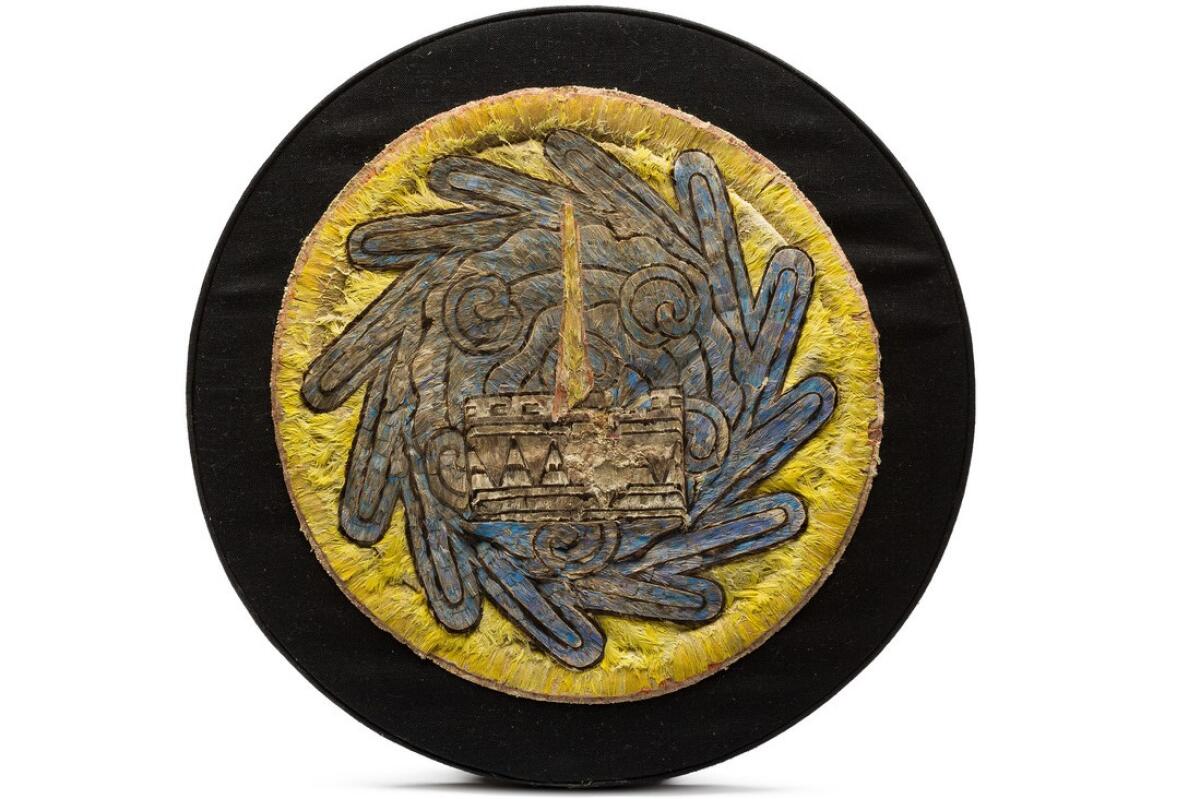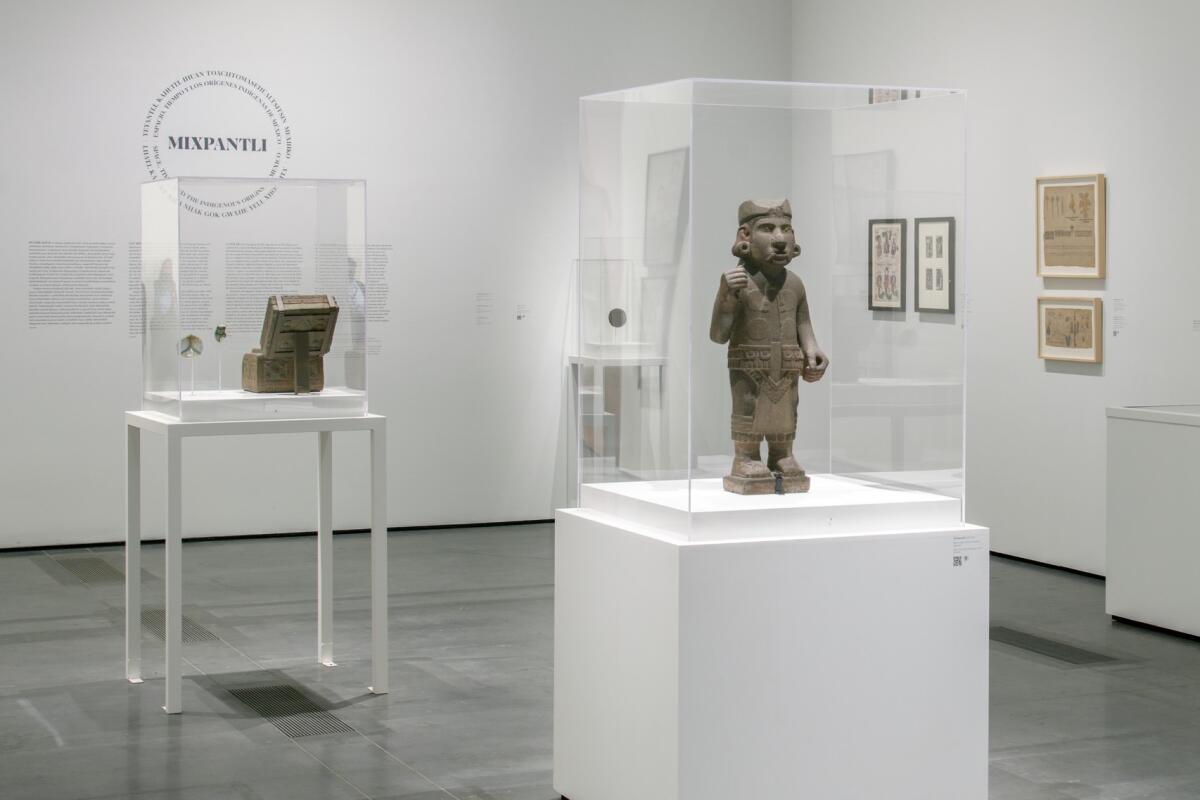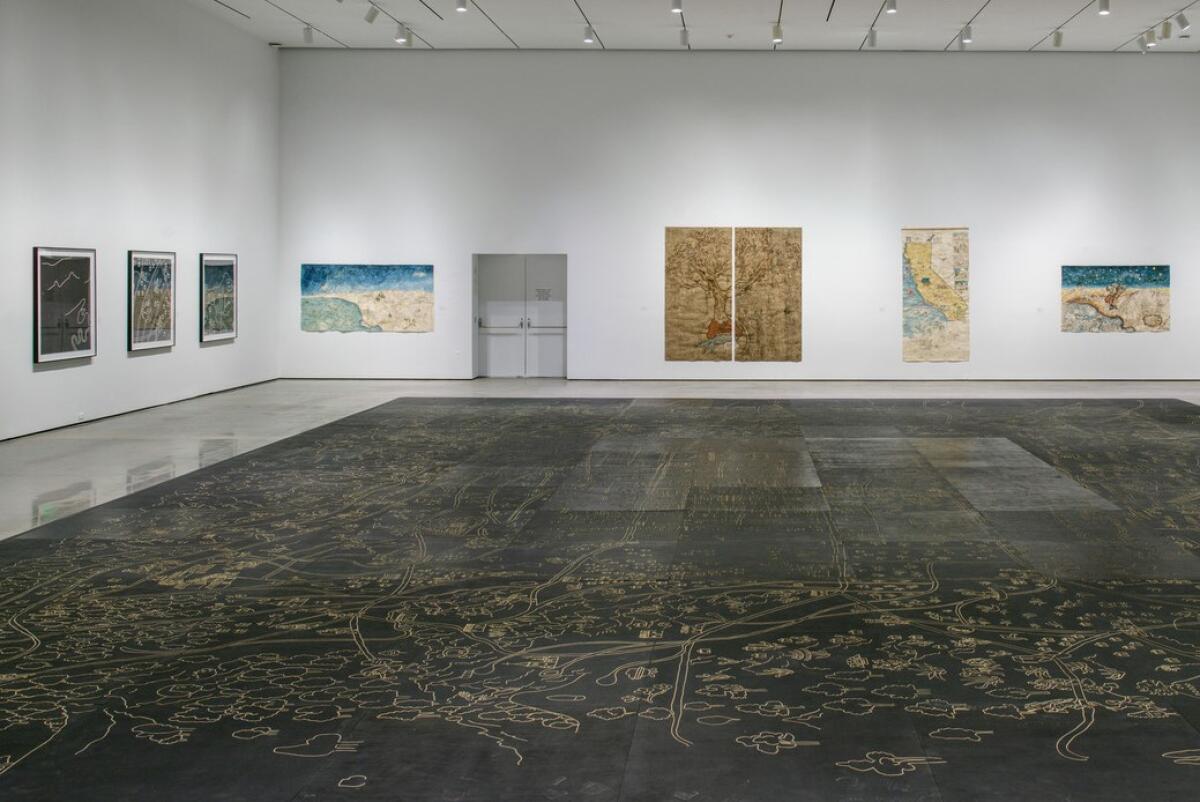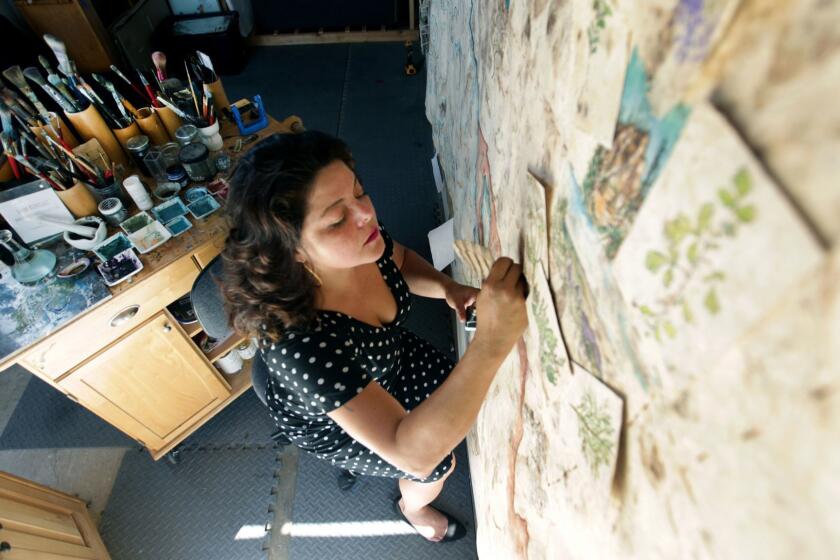Review: The conquered rather than the conquerors are given the stage in LACMAâs two new âMixpantliâ exhibits

One of the most intriguing features of a pair of loosely linked small shows at the Los Angeles County Museum of Art comes in an unexpected place â the wall texts at the entry.
Usually, reading the content of such a text orients a visitor to what is about to unfold in the exhibition. In this case, that would be âMixpantli: Space, Time, and the Indigenous Origins of Mexico,â which makes note of the 500th anniversary of the fall of the Aztec capital, Tenochtitlan (modern-day Mexico City), and the related âMixpantli: Contemporary Echoes,â which features a few examples of recent art.
But here, the content doesnât do the heavy lifting. Instead, the language itself does â language that almost no one who goes to see the show will be able to read in all its nuances.
Thatâs because the brief introductory text is written in four different ones.
Nahuatl was spoken by the Aztecs (or Mexica) at the time of the European conquest of Mesoamerica and is still used in some places today. (The Nahuatl word âmixpantliâ refers to an early omen of the coming conquest.) Zapotec is an indigenous tongue from the south, especially in the area around Oaxaca. Spanish and English came later, brought by Europeans and Americans.
The four texts are lined up on the entry wall, left to right: first Nahuatl, then Zapotec, next Spanish and finally English. All four languages are spoken now in parts of Mexico and Los Angeles, although few people probably speak all of them. Unversed in Nahuatl or Zapotec, the order of the texts meant that I was locked out until more than halfway in.
That was helpful. The sequence was effective in reversing the usual reckoning of the Spanish conquest of Mexico, typically told from a Western point of view.
This time, itâs the conquered rather than the conquerors who are given the stage. The show means to look at how Indigenous people absorbed aspects of their vanquishersâ worldview into their own.

Thatâs a key shift in art scholarship that has been underway for some time. The Getty Research Institute, for example, has been engaged in creating a complex, searchable digital translation of the famous Florentine Codex. (Completion is targeted for 2023.) Penned and illuminated over 30 years early in the 16th century, the 12-volume manuscript documenting Aztec history, culture, politics, economics and natural science is housed in Florenceâs Laurentian Library. Italyâs acquisitive Medici dynasty acquired it a few decades after the codex was completed.
Encyclopedic, with some 1,200 pages and nearly 2,500 illustrations, it was compiled by a sizable team of Indigenous artists and authors working with a Franciscan friar at the Colegio de Santa Cruz de Tlatelolco, Mexicoâs first college. The book is written in Spanish and Nahuatl, its side-by-side columns concluding with a detailed account of the conquest.
Tellingly, the Nahuatl version of the war is considerably longer, reported as more brutally complete than the Spanish. The coming digitized translation should be an eye-opener for English-speakers.
The exhibition at LACMA tries for something similar, but the result is mixed. One main reason is that the show is very small â just 30 objects, more than half of them facsimiles rather than historic art objects. (A 1979 printed book of the Florentine Codex is in a display case, for instance, while lining walls are 12 small copies of historic maps and five other period documents, recently hand-painted by Mexico City graphic artist Tlaoli Ramirez TĂŠllez.) Something of a thumbnail sketch, it has no catalog.
A handful of exceptional works are on view, among them a face-off between two stone carvings. One is a 16th century cross, 5 feet tall, the arms embellished with the familiar Christian symbols of the Passion â a pair of dice, pliers, nails, a crowing cock, etc. â surrounding Jesusâ head. The other is a blocky basalt figure of the Aztec fire deity Xiuhtecuhtli, or âTurquoise Lord.â The sculpture dates from between 1250, when the Aztecs arrived in Chapultepec, and 1521, when HernĂĄn CortĂŠs defeated them.
One job of the deity, rendered in the form of a sturdy, 2½-foot-tall square column, is to usher in regularly changing but epic cycles of history. (The dark volcanic rockâs columnar shape makes it seem he could hold up the sky.) Heâs paired with the huge transformation implied by the mythic resurrection of Jesus, embedded in the cross.
Making that connection requires prior knowledge of an Aztec Nahua worldview. Even then, itâs hard to parse the precise relationship between the two works. The deity was surely carved by a Nahua artist immersed in his cultureâs religion, while the cross may (or may not) have been carved by an Aztec but just as surely happened at the direction of a Spanish colonist.
Colonial Mexico was rife with art objects made at the behest of the conquerors expressly to speak in terms the conquered already understood. Did the artist who carved the cross also take liberties, which only informed Nahuas would grasp? Maybe, but thereâs no evident indication of that. Indigenous or foreign-born, the patron makes a big difference.

A gorgeous 16th century cover for a wine chalice used in the Roman Catholic Eucharist is another example. Decorated with luxurious feathers from parrots and ducks, it employs Nahuatl iconography, such as creationâs turbulent waters. But thereâs no way to know who determined the imagery, conquered artist or conquering European churchman. Given the mystical centrality of the Eucharist, itâs doubtful the patron just gave the artist free rein.
That liberty is a conception of the modern West about how artists should work, and itâs on view in the second show. Mapping is its focus, and the artists are mostly women.
A marvelous interactive video-map produced by Comunidades IndĂgenas en liderazgo (CIELO), a group of mostly L.A. women, charts the whereabouts of language groups resident across the county â Chinanteco, Mam, Kâicheâ and more. Itâs an e pluribus unum of diversity spoken in a map made in a shared digital language.
Lovely painted Southland maps by the impressive Sandy Rodriguez chronicle grim subjects like children killed in U.S. Customs and Border Patrol custody and neighbors slain by police during pandemic-year protests. Rodriguez paints with materials and techniques predating colonization. The jarring collision of charming form and ugly content â skull-faced police helicopters, for instance â yields a potent condensation of asymmetrical power relationships.
Riffle through Sandy Rodriguezâs dense rack of painting supplies and youâll turn up feathers, withered plants and a container of cochineal powder, the fiery red tint produced by the insect that feeds on the leaves of the prickly pear cactus.
Finally, âVista de ojosâ (View of the Eyes), a 2014 floor sculpture by Mariana Castillo Deball, is composed of black panels of laser-cut wood reproducing a map of Mexico City believed to have been drawn by an Aztec cartographer in the mid-16th century. In the center, the Spanish-built city centered on a cathedral is devoid of human life, save for the organized evidence of architecture and urban planning. Around the periphery, the rambling countryside teems with Indigenous life â streams becoming thoroughfares, pigs and cattle being herded, fights breaking out, firewood being bundled and much more.
But a city is not a dead place, and a countryside is not so haphazard. The ancient map nests two visions: One image is drawn from an experience of being excluded from participation, the other from deep immersion in it. Deball provides paper booties so visitors may don them to venture out onto her room-filling floor-piece. With eyes open, you move across a nominal pedestal on which todayâs world has been built.
'Mixpantli' shows
What: âMixpantli: Space, Time, and the Indigenous Origins of Mexico,â through May 1, and âMixpantli: Contemporary Echoes,â through June 12
Where: Los Angeles County Museum of Art, 5905 Wilshire Blvd., L.A.
Info: lacma.org
More to Read
The biggest entertainment stories
Get our big stories about Hollywood, film, television, music, arts, culture and more right in your inbox as soon as they publish.
You may occasionally receive promotional content from the Los Angeles Times.













